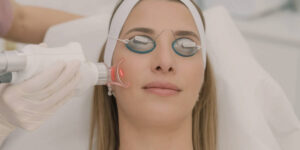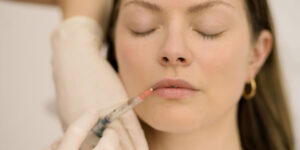Botulinum Toxin
Botulinum toxin, also known as Botox, is a popular cosmetic treatment that can help reduce the appearance of fine lines and wrinkles. It is produced by the bacteria Clostridium Botulinum and works by blocking the signals that cause muscle contractions. When injected into the muscles, it causes them to relax and soften, resulting in a smoother and more youthful appearance.
Botox is a versatile treatment that can be used for a variety of cosmetic and medical purposes. At Fitzrovia Clinic, our Botox treatments include:
- Wrinkles and fine lines: Botox is commonly used on the forehead, between the eyebrows and around the eyes. It can also produce excellent results rejuvenating the lower face.
- Gummy smile: Botox injections can relax muscles pulling the upper lip, exposing less of the upper gums and creating a more aesthetically pleasing smile.
- Excessive sweating: Botox alleviates hyperhidrosis, (excessive sweating), by blocking signals from the nerves that stimulate sweat glands, which in turn reduces sweat production.
- Teeth grinding: Botox injections relax muscles to alleviate bruxism, (teeth grinding and clenching), which reduces pain and prevents tooth damage.
- Migraines: Botox injections have also been approved for the treatment of chronic migraines; a condition characterised by recurring headaches that can last for several days.
- Facial asymmetry: Facial asymmetry caused by muscle imbalances can be corrected using Botox, leading to a more aesthetically pleasing appearance.
- Square jawline: To achieve a slimmer jawline, Botox can be used to relax the muscles that contribute to a wider, more square appearance.
FAQs
Botox is an effective treatment for reducing wrinkles and addressing conditions such as migraines, excessive sweating (hyperhidrosis), and teeth clenching/grinding (bruxism). However, Botox treatment is not suitable if you:
- Are pregnant or breastfeeding
- Have an allergy to Botulinum toxin
- Are taking aminoglycoside antibiotics (e.g., gentamycin)
- Have a skin infection in the desired treatment area
- Have a condition affecting nerve-muscle connections (e.g., myasthenia gravis or Eaton-Lambert syndrome)
At Fitzrovia Clinic, we offer a comprehensive consultation to understand your treatment goals and create a safe and effective plan. We review your medical history, take clinical photographs, and provide ample time for questions. After obtaining your consent, our doctors personalize treatments based on your facial anatomy, concerns, and goals, ensuring natural-looking results. The treatment involves painless, small injections using a fine needle, lasting a few minutes. Results typically last 3-4 months, with potential for longer-lasting effects after repeated treatments.
The effects of Botox can be seen within a few days after treatment, with full results visible within two weeks. At Fitzrovia Clinic we invite all patients to attend a review appointment 2-4 weeks after treatment to review your results and make any adjustments if needed. There is no charge for this appointment.
From 6-8 weeks after treatment, you may notice the muscles moving a little more as the effects gradually wear off. The effects typically last for 3-6 months, after which time the procedure may be repeated to maintain the desired results.
In the UK, Botox®, Azzalure®, and Bocouture® are the most commonly used botulinum toxin products for cosmetic and medical purposes. While each brand contains the same active ingredient, the manufacturing processes and dosages can vary, which results in differences in efficacy and longevity.
Each product has its own unique properties, and what works best for one person may not be the best option for another. Our doctors at Fitzrovia clinic will discuss your individual needs to help determine which product is best for you.
When Botox wears off, the muscle activity gradually returns to its pre-treatment state, and the wrinkles and lines that were smoothed out will reappear. This usually happens over the course of 2-3 months, however the exact timing can vary depending on the individual and the area that was treated.
If you want to maintain the results of your Botox treatment, we recommend repeat treatments every 3-6 months, though the exact length will vary from person to person.
At Fitzrovia Clinic, our highly experienced doctors use specialist hair-thin needles to limit any discomfort. For some patients, there is no pain at all, for others some areas may sting slightly, but this will only last the length of the injection. There is no discomfort at all after the treatment.
To prepare for Botox treatment at Fitzrovia Clinic:
- Consult with our doctors for personalised guidance, risks, and alternatives.
- Avoid blood-thinning medications like aspirin and ibuprofen for a week before treatment.
- Avoid alcohol 24 hours before the procedure.
- Inform our doctors about your current medications.
- Reschedule if you’re unwell.
- Take time to read the consent form and ask our team about any questions you may have.
- Follow our aftercare instructions carefully.
Botox is often referred to as a quick procedure with minimal recovery time. Occasionally, there may be some mild swelling or redness at the injection site, but these typically resolve within 15 minutes after treatment.
Botox treatments are safe and serious side effects are extremely rare. It’s important to note that the risks and side effects of Botox can vary depending on the specific area being treated.
Some potential risks include:
- Pain and bruising at the injection site
- Headache
- Uneven/asymmetrical result
- Flu-like symptoms
- Droopy eyelid/eyebrow
- Crooked smile
Please discuss any concerns with our professionals at Fitzrovia Clinic, or your own health care practitioner.
Botox is a safe and effective treatment for dynamic lines and wrinkles, however there are other treatment options which may also improve their appearance, many of which we offer at Fitzrovia Clinic. These include:
- Collagen supplements: supplements that are taken orally or applied topically to promote collagen production and improve skin elasticity.
- Skin boosters: a treatment that involves injecting hyaluronic acid into the skin to improve hydration and texture.
- Microneedling: tiny needles are used to create small punctures in the skin, stimulating collagen production and improving skin texture.
- Chemical peels: the application of a solution to the skin helps remove damaged outer layers and promotes the growth of new skin cells.
- Radiofrequency microneedling: radiofrequency energy is delivered into the skin using tiny needles to stimulate collagen production and improve skin texture.
- CO2 laser: a skin resurfacing treatment that uses a carbon dioxide laser to remove damaged skin and stimulate collagen production.
- Laser genesis: a non-invasive laser treatment that targets the deeper layers of the skin to promote collagen production and improve the appearance of fine lines and wrinkles.
- Limelight IPL (intense pulsed light): a non-surgical method of improving skin texture, reducing redness, and addressing pigmentation through the use of intense light pulses.











